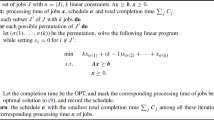Abstract
The planning and scheduling of repetitive PCB assembly is usually very complicated.In this paper, we propose a solution method for the simultaneous determination of theassignment of different PCB types to capacity constrained assembly lines, the assemblycycle times of the PCB types, and the reorder intervals of the required component types.This method takes the limited capacity into account as well as the component commonality ofthe PCB types. The solution method consists of two heuristics. The first heuristic determinesthe cycle times of the PCB types and the reorder intervals of the component types in orderto minimise the sum of the set‐up, holding, and ordering costs for given assignments.This method is used as a sub‐algorithm in the second heuristic, a local searchalgorithm. The latter heuristic defines an assignment for which a local minimum of cost isachieved. A case study has been carried out in which the algorithm has been applied toreal‐life data. It appears that the present cost can be reduced by almost 38%.
Similar content being viewed by others
References
A.L. Arcus, COMSOAL, a computer method of sequencing operations for assembly lines, The International Journal of Production Research 4/4(1966)259-277.
R.H. Ahmadi, A hierarchical approach to design, planning, and control problems in electronic circuit card manufacturing, in: Perspectives in Operations Management, ed. R.K. Sarin, Kluwer Academic, Dordrecht, 1993.
R.H. Ahmadi and P. Kouvelis, Staging problem of a dual delivery pick-and-place machine in printed circuit card assembly, Operations Research 42(1994)81-91.
J.C. Ammons, M. Carlyle, L. Cranmer, G. DePuy, K. Ellis, L.F. McGinnis, C.A. Tovey and H. Xu, Component allocation to balance workload in printed circuit card assembly systems, IIE Transactions 29(1997)265-275.
R.G. Askin, M. Dror and A.J. Vakharia, Printed circuit board family grouping and component allocation for a multimachine, open-shop assembly cell, Naval Research Logistics 41(1994)587-608.
M.S. Bazaraa, H.D. Sherali and C.M. Shetty, Nonlinear Programming; Theory and Algorithms, Wiley, New York, 1993.
Y. Crama, O.E. Flippo, J. van de Klundert and F.C.R. Spieksma, The assembly of printed circuit boards: A case with multiple machines and multiple board types, European Journal of Operational Research 98(1997)457-472.
M.L. Fisher, The Lagrangian relaxation method for solving integer programming problems, Management Science 27(1981)1-18.
M. Grunow, H.O. Günther and R. Mühlhäusser, Optimisation of SMD-placement operations in high-volume PCB assembly, in: Proceedings of the Workshop on Production Planning and Control, Mons, Belgium, 1996, pp. 217-220.
H.O. Günther, M. Gronalt and R. Zeller, Job sequencing and component set-up on a surface mount placement machine, in: Proceedings of the 13th International Conference on Production Research, eds. E. Dar-El, R. Karni, Y. Herer, Jerusalem, 1995, pp. 340-343.
P.L. Jackson, W.L. Maxwell and J.A. Muckstadt, Determining optimal reorder intervals in capacitated production-distribution systems, Management Science 34(1988)938-958.
M.E. Johnson and S. Jain, Reducing set-up time in printed circuit assembly through production sequencing, in: MSOM Conference Proceedings, INFORMS, June 24-25 1996, pp. 276-281.
S. Lin and B.W. Kernighan, An effective heuristic algorithm for the travelling salesman problem, Operations Research 21(1973)498-516.
D. Luzzatto and M. Perona, Cell formation in PCB assembly based on production quantitative data, European Journal of Operational Research 69(1993)312-329.
O.Z. Maimon, E.M. Dar-El and T.F. Carmon, Set-up saving schemes for printed circuit boards assembly, European Journal of Operational Research 70(1993)177-190.
W.L. Maxwell and J.A. Muckstadt, Establishing consistent and realistic reorder intervals in production-distribution systems, Operations Research 33(1985)1316-1341.
L.F. McGinnis, J.C. Ammons, M. Carlyle, L. Cranmer, G.W. Depuy, K.P. Ellis, C.A. Tovey and H. Xu, Automated process planning for printed circuit card assembly, IIE Transactions 24(1992)18-30.
I. Or and E. Duman, Optimisation issues in automated production of printed circuit boards: Operations sequencing, feeder configuration and load balancing problems, in: Proceedings of the Workshop on Production Planning and Control, Mons, Belgium, 1996, pp. 165-170.
K. Raj Kumar and T.T. Narendran, A heuristic for sequencing PCBs with due-dates, International Journal of Operations and Production Management 17(1997)446-467.
A. Rothhaupt, Optimierte Planung in der Elektronikfertigung, Die Fachzeitschrift für Elektronik-Fertigung und Test, Productronic 3(1995)58-65.
M. Sadiq, T.L. Landers and G.D. Taylor, A heuristic algorithm for minimising total production time for a sequence of jobs on a surface mount placement machine, International Journal of Production Research 31(1993)1327-1341.
L.R. Schwarz and L. Schrage, Optimal and system myopic policies for multi-echelon production/inventory assembly systems, Management Science 22(1975)1285-1294.
P.J.M. van Laarhoven and W.H.M. Zijm, Production preparation and numerical control in PCB assembly, The International Journal of Flexible Manufacturing Systems 5(1993)187-207.
J.I. van Zante-de Fokkert and A.G. de Kok, The assignment of items to resources: The impact of incorrect cost definitions, Working Paper TM/LBS/97-05, Eindhoven University of Technology, 1997.
Rights and permissions
About this article
Cite this article
van Zante-de Fokkert, J., de Kok, A. The simultaneous determination of the assignment ofitems to resources, the cycle times, and the reorderintervals in repetitive PCB assembly. Annals of Operations Research 92, 381–401 (1999). https://doi.org/10.1023/A:1018903302505
Issue Date:
DOI: https://doi.org/10.1023/A:1018903302505




